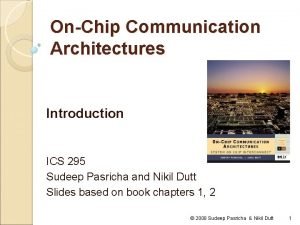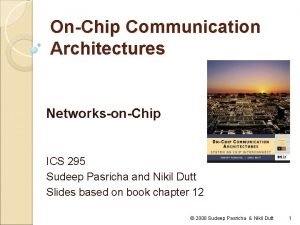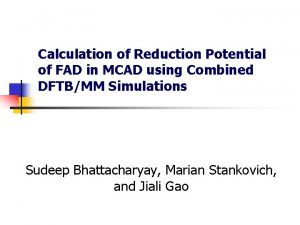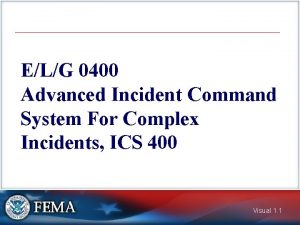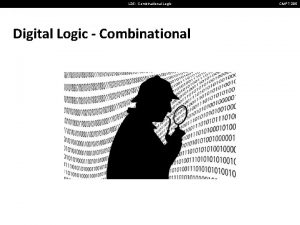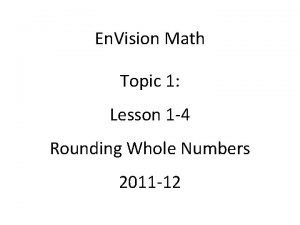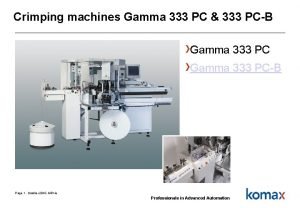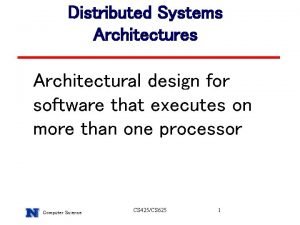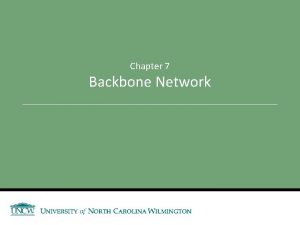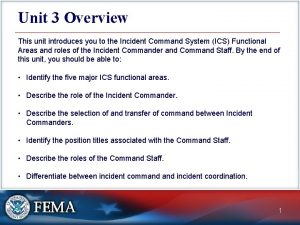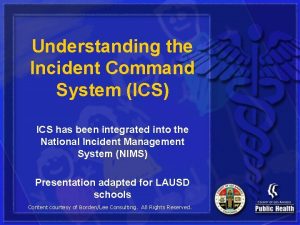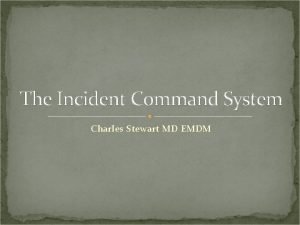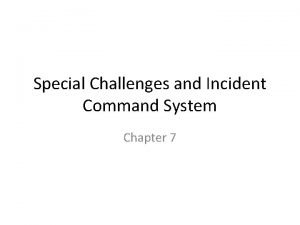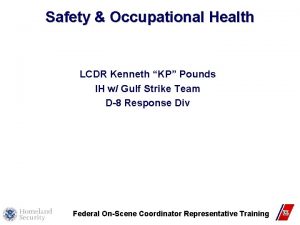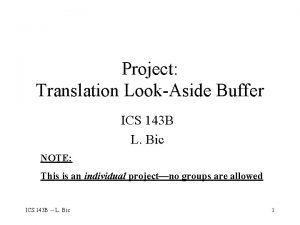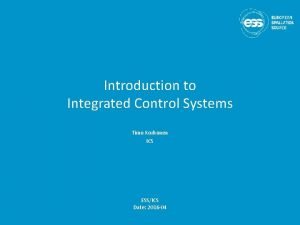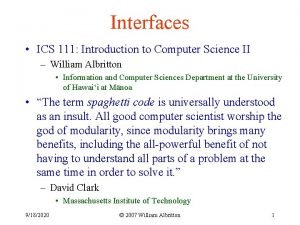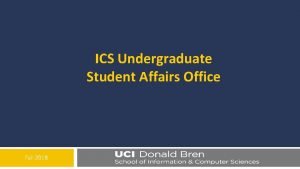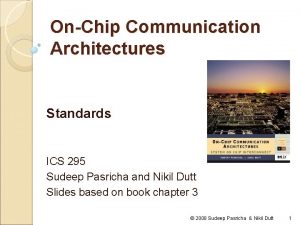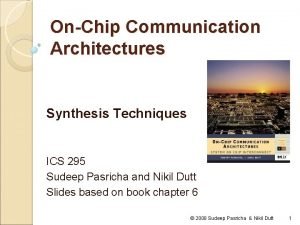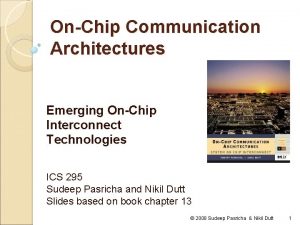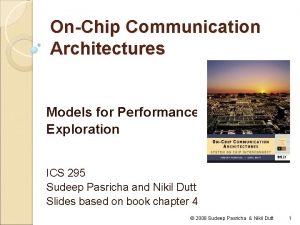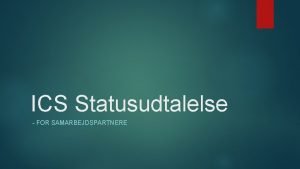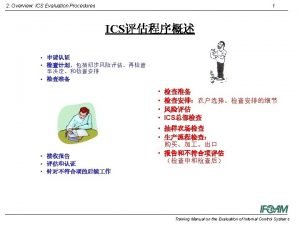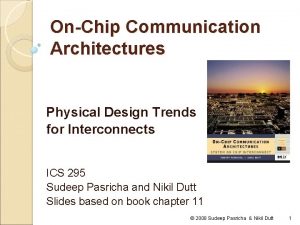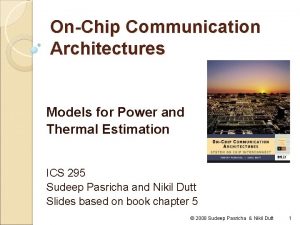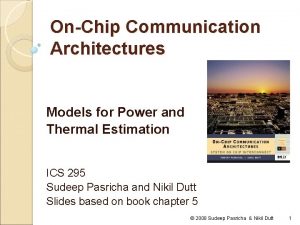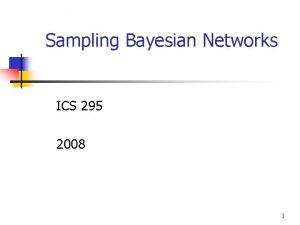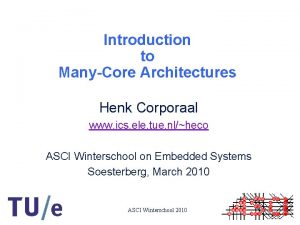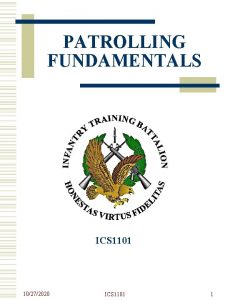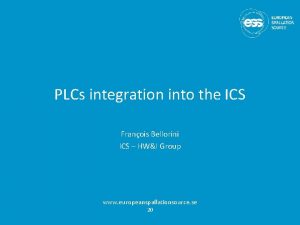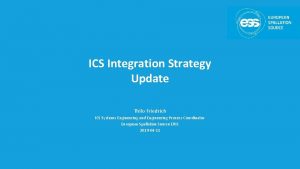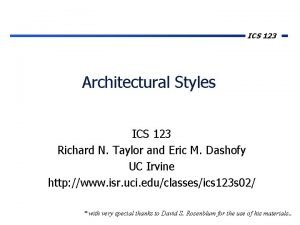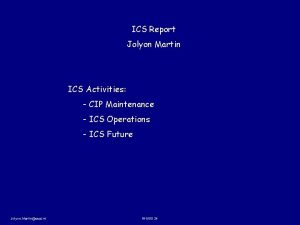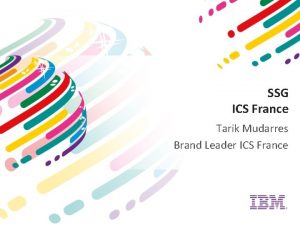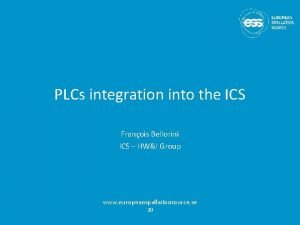OnChip Communication Architectures Introduction ICS 295 Sudeep Pasricha

















































- Slides: 49

On-Chip Communication Architectures Introduction ICS 295 Sudeep Pasricha and Nikil Dutt Slides based on book chapters 1, 2 © 2008 Sudeep Pasricha & Nikil Dutt 1

Outline Introduction to So. C Design Trends Significance of on-chip communication architectures Bus-based communication architectures ◦ ◦ ◦ ◦ Terminology Physical structure Clocking Arbitration and decoding Topology types Data transfer modes Physical implementation issues © 2008 Sudeep Pasricha & Nikil Dutt DSM effects 2

Designer Productivity Gap So. C designs today are complex, characterized by more and more IPs being integrated on a single chip, and a shrinking time-to-market © 2008 Sudeep Pasricha & Nikil Dutt 3

Emerging Application Requirements © 2008 Sudeep Pasricha & Nikil Dutt 4

Coping with So. C Complexity Practicing IP based Design and Reuse ◦ Raising the reuse factor from standard cells to IP blocks e. g. predesigned hardware IPs for processors (ARM, Power. PC), communication (AMBA, Core. Connect), memories (Samsung SDRAMs, Denali SRAMs), I/O (UART, USB) etc. ◦ IPs not just for hardware, but for software (device drivers, OS) too ◦ Substantial reduction in So. C design and verification time ◦ Requires initial investment to create reusable cores but productivity improves with reuse IP Interfacing Standards ◦ IP based design needs to handle incompatible IP interfaces ◦ Assembling heterogeneous IPs for So. C design can take months!!! ◦ Need for unified standard to quickly connect IPs e. g. OCP-IP, VSIA VCI etc. © 2008 Sudeep Pasricha & Nikil Dutt 5

Coping with So. C Complexity Platform based Design ◦ Design paradigm which promotes IP based design and reuse ◦ A meet-in-the-middle approach maps application to a customizable design consisting of HW, SW IPs ◦ Platforms use IPs; but will soon become the IPs of the future e. g. Phillips Nexperia, ARM Prime. Xsys platform etc. Decouples the application development process from the architectural implementation process. © 2008 Sudeep Pasricha & Nikil Dutt 6

Data Flow Replacing Data Processing As Major So. C Design Challenge µP Core 1 So. Cs Core 2 Circa 2002 Core N Main Bus µP µP Mem Bus Sub system I/O Bus DRAMC So. Cs Circa 2008 Critical Decision Was u. P Choice q Exploding core counts requiring more advanced Interconnects q EDA cannot solve this architectural problem easily q Complexity too high to hand craft (and verify!) Critical Decision Is Interconnect Choice Communication Architecture Design and Verification becoming Highest Priority in Contemporary So. C Design! Source: SONICS Inc. © 2008 Sudeep Pasricha & Nikil Dutt 7

Examples of On-chip Communication Architectures IBM Cell ring bus communication architecture © 2008 Sudeep Pasricha & Nikil Dutt 8

Ideal ESL Design Flow © 2008 Sudeep Pasricha & Nikil Dutt 9

Need for Communication-centric Design Flow Communication is THE most critical aspect affecting system performance Communication architecture consumes upto 50% of total on-chip power Ever increasing number of wires, repeaters, bus components (arbiters, bridges, decoders etc. ) increases system cost Communication architecture design, customization, exploration, verification and implementation takes up the largest chunk of a design cycle Communication Architectures in today’s complex systems significantly affect performance, power, cost and time-to-market! © 2008 Sudeep Pasricha & Nikil Dutt 10

Technology Scaling Trends: Total Interconnect Length on a Chip Highlights importance of interconnect design in future technologies © 2008 Sudeep Pasricha & Nikil Dutt 11

Technology Scaling Trends: Interconnect Performance Relative delay comparison of wires vs. process technology Increasing wire delay limits achievable performance © 2008 Sudeep Pasricha & Nikil Dutt 12

Bus based On-Chip Communication Architectures Buses are the simplest and most widely used So. C interconnection networks Bus: ◦ a collection of signals (wires) to which one or more IP components (which need to communicate data with each other) are connected Only one IP component can transfer data on the shared bus at any given time Microcontroller Digital Signal Processor Input/ Output Device Memory Bus © 2008 Sudeep Pasricha & Nikil Dutt 13

Bus Terminology © 2008 Sudeep Pasricha & Nikil Dutt 14

Bus Terminology Master (or Initiator) ◦ IP component that initiates a read or write data transfer Slave (or Target) ◦ IP component that does not initiate transfers and only responds to incoming transfer requests Arbiter ◦ Controls access to the shared bus ◦ Uses arbitration scheme to select master to grant access to bus Decoder ◦ Determines which component a transfer is intended for Bridge ◦ Connects two busses ◦ Acts as slave on one side and master on the other © 2008 Sudeep Pasricha & Nikil Dutt 15

Bus signal lines address lines data lines control lines A bus typically consists of three types of signal lines ◦ Address Carry address of destination for which transfer is initiated Can be shared or separate for read, write data ◦ Data Carry information between source and destination components Can be shared or separate for read, write data Choice of data width critical for application performance ◦ Control Requests and acknowledgements Specify more information about type of data transfer Byte enable, burst size, cacheable/bufferable, writeback/through, … © 2008 Sudeep Pasricha & Nikil Dutt 16

Types of Bus Topologies Shared bus © 2008 Sudeep Pasricha & Nikil Dutt 17

Types of Bus Topologies Hierarchical shared bus Improves system throughput Multiple ongoing transfers on different buses © 2008 Sudeep Pasricha & Nikil Dutt 18

Types of Bus Topologies Split bus Reduces impact of capacitance across two segments Reduces contention and energy © 2008 Sudeep Pasricha & Nikil Dutt 19

Types of Bus Topologies Full crossbar/matrix bus (point to point) © 2008 Sudeep Pasricha & Nikil Dutt 20

Types of Bus Topologies Partial crossbar/matrix bus © 2008 Sudeep Pasricha & Nikil Dutt 21

Types of Bus Topologies Ring bus © 2008 Sudeep Pasricha & Nikil Dutt 22

Bus Physical Structure tri-state buffer based bidirectional signals Commonly used in off-chip/backplane buses ◦ + take up fewer wires, smaller area footprint © 2008 Sudeep Pasricha ◦ - higher power consumption, higher delay, hard to debug & Nikil Dutt 23

Bus Physical Structure MUX Separate based signals read, write channels © 2008 Sudeep Pasricha & Nikil Dutt 24

Bus Physical Structure AND-OR based signals © 2008 Sudeep Pasricha & Nikil Dutt 25

Bus Clocking Synchronous ◦ ◦ Bus Includes a clock in control lines Fixed protocol for communication that is relative to clock Involves very little logic and can run very fast Require frequency converters across frequency domains © 2008 Sudeep Pasricha & Nikil Dutt 26

Bus Clocking Asynchronous Bus ◦ Not clocked ◦ Requires a handshaking protocol performance not as good as that of synchronous bus No need for frequency converters, but does need extra lines ◦ Does not suffer from clock skew like the synchronous bus © 2008 Sudeep Pasricha & Nikil Dutt 27

Decoding and Arbitration Decoding ◦ determines the target for any transfer initiated by a master Arbitration ◦ decides which master can use the shared bus if more than one master request bus access simultaneously Decoding and Arbitration can either be ◦ centralized ◦ distributed © 2008 Sudeep Pasricha & Nikil Dutt 28

Centralized Decoding and Arbitration Minimal change is required if new components are added to the system © 2008 Sudeep Pasricha & Nikil Dutt 29

Distributed Decoding and Arbitration + requires fewer signals compared to the centralized approach - more hardware duplication, more logic/area, less © 2008 Sudeep Pasricha & Nikil Dutt scalable 30

Arbitration Schemes Random ◦ Randomly select master to grant bus access to Static priority ◦ Masters assigned static priorities ◦ Higher priority master request always serviced first ◦ Can be pre-emptive (AMBA 2) or non-preemptive (AMBA 3) ◦ May lead to starvation of low priority masters RR ◦ Masters allowed to access bus in a round-robin manner ◦ No starvation – every master guaranteed bus access ◦ Inefficient if masters have vastly different data injection rates © 2008 Sudeep Pasricha & Nikil Dutt 31

Arbitration Schemes TDMA ◦ Time division multiple access ◦ Assign slots to masters based on BW requirements ◦ If a master does not have anything to read/write during its time slots, leads to low performance ◦ Choice of time slot length and number critical TDMA/RR ◦ Two-level scheme ◦ If master does not need to utilize its time slot, second level RR scheme grants access to another waiting master ◦ Better bus utilization ◦ Higher implementation cost for scheme (more logic, 32 © 2008 Sudeep Pasricha & Nikil Dutt

Arbitration Schemes Dynamic priority ◦ Dynamically vary priority of master during application execution ◦ Gives masters with higher injection rates a higher priority ◦ Requires additional logic to analyze traffic at runtime ◦ Adapts to changing data traffic profiles ◦ High implementation cost (several registers to track priorities and traffic profiles) Programmable priority ◦ Simpler variant of dynamic priority scheme ◦ Programmable register in arbiter allows software to change priority © 2008 Sudeep Pasricha & Nikil Dutt 33

Bus Data Transfer Modes Single Non-pipelined Transfer ◦ Simplest transfer mode first request for access to bus from arbiter on being granted access, set address and control signals Send/receive data in subsequent cycles © 2008 Sudeep Pasricha & Nikil Dutt 34

Bus Data Transfer Modes Pipelined Transfer ◦ Overlap address and data phases Only works if separate address and data busses are present © 2008 Sudeep Pasricha & Nikil Dutt 35

Bus Data Transfer Modes Non-pipelined Burst Transfer ◦ Send multiple data items, with only a single arbitration for entire transaction master must indicate to arbiter it intends to perform burst transfer Saves time spent requesting for arbitration © 2008 Sudeep Pasricha & Nikil Dutt 36

Bus Data Transfer Modes Pipelined Burst Transfer ◦ Useful when separate address and data buses available ◦ Reduces data transfer latency © 2008 Sudeep Pasricha & Nikil Dutt 37

Bus Data Transfer Modes Split Transfer ◦ If slaves take a long time to read/write data, it can prevent other masters from using the bus ◦ Split transfers improve performance by ‘splitting’ a transaction Master sends read request to slave Slave relinquishes control of bus as it prepares data Arbiter can grant bus access to another waiting master Allows utilizing otherwise idle cycles on the bus When slave is ready, it requests bus access from arbiter On being granted access, it sends data to master ◦ Explicit support for split transfers required from slaves and arbiters (additional signals, logic) © 2008 Sudeep Pasricha & Nikil Dutt 38

Bus Data Transfer Modes Out-of-Order Transfer ◦ Allows multiple transfers from different masters, or even from the same master, to be SPLIT by a slave and be in progress simultaneously on a single bus ◦ Masters can initiate data transfers without waiting for earlier data transfers to complete ◦ Allows better parallelism, performance in buses ◦ Additional signals are needed to transmit IDs for every data transfer in the system ◦ Master interfaces need to be extended to handle data transfer IDs and be able to reorder received data ◦ Slave interfaces have out-of-order buffers for reads, writes, to keep track of pending transactions, plus logic for processing IDs 2008 Sudeep & Nikil Dutt Any application typically has a limited©buffer size. Pasricha beyond which 39

Bus Data Transfer Modes Broadcast Transfer ◦ Every time a data item is transmitted over a bus, it is physically broadcast to every component on the bus ◦ Useful for snooping and cache coherence protocols ◦ Example: when several components on bus have a private cache fed from a single memory, a problem arises when the memory is updated when a cache line is written to memory by a component ◦ It is essential that private caches of the components on the bus invalidate (or update) their cache entries to prevent reading incorrect values ◦ Broadcasting allows address of the memory location (or cache line) being updated to be transmitted to all the components on the bus, so they can invalidate (or update) their local copies © 2008 Sudeep Pasricha & Nikil Dutt 40

Physical implementation issues for bus wires Bus wires are implemented as long metal lines on a silicon wafer ◦ transmitting data using electromagnetic waves (finite speed limit) As application performance requirements increase, clock frequencies are also increasing ◦ Greater bus clock frequency = shorter bus clock period 100 MHz = 10 ns ; 500 MHz = 2 ns Time allowed for a signal on a bus to travel from source to destination in a single bus clock cycle is decreasing Can take multiple cycles to send a signal across a chip ◦ 6 -10 bus clock cycles @ 50 nm © 2008 Sudeep Pasricha & Nikil Dutt 41

Physical implementation issues for bus wires Partition long bus wires into shorter ones ◦ Hierarchical or split bus communication architectures ◦ Register slices or buffers to pipeline long bus wires enable signal to traverse a segment in a single clock cycle Asynchronous buses ◦ No clock signal Low level techniques ◦ Inserting repeaters or using fat wires © 2008 Sudeep Pasricha & Nikil Dutt 42

Buses in the DSM era With CMOS process technology scaling below 90 nm, So. Cs have entered the DSM era ◦ High levels of component integration ◦ High clock frequencies ◦ Low signal voltages Buses significantly impacted by DSM effects ◦ Signal integrity issues scenario where the received signal at the destination is different from the transmitted signal at the source driver noise caused due to following factors crosstalk external electromagnetic interference transmission line effects soft errors © 2008 Sudeep Pasricha & Nikil Dutt 43

DSM Effects Crosstalk ◦ Phenomenon of noise being caused on a signal A due to the coupling with another signal B due to the close proximity of bus wires near-field electromagnetic coupling causes inductive and capacitive crosstalk on bus signals ◦ Even when wires are far apart, crosstalk can still occur due to coupling facilitated by common substrate, shared power supply or ground, or a shared signal return path ◦ As wires become narrower with scaling and clock frequencies increase, fringing field effects and inductance effects become larger for wires higher inductive and capacitive crosstalk © 2008 Sudeep Pasricha & Nikil Dutt 44

DSM Effects Electromagnetic interference (EMI) ◦ Phenomenon of large external electric and magnetic fields coupling into circuits and creating unwanted noise ◦ EMI due to external and internal coupling is expected to increase with evolving technology As highly integrated, portable wireless communication So. Cs increasingly consist of analog, RF, and digital circuits ◦ Long on-chip buses in particular will be the sources and receptors of EMI noise © 2008 Sudeep Pasricha & Nikil Dutt 45

DSM Effects Transmission line effects ◦ when a wire is longer than 1/10 of the wavelength of the signal frequency component that is transmitted, the wave nature of the propagated signal must be modeled otherwise significant errors may result. ◦ wires will thus have to be modeled as transmission lines to avoid errors during signal analysis ◦ Discontinuities in these transmission lines can result in impedence mismatches due to various factors such as capacitive loads, vias, wire bends, package pins, crossover wires, and non-ideal receivers ◦ Such mismatches will create noise as a result of signal reflections at the discontinuities © 2008 Sudeep Pasricha & Nikil Dutt 46

DSM Effects Soft Errors ◦ Phenomenon of spurious pulses and interference with signals on buses ◦ Caused by collision of thermal neutrons produced by the decay of cosmic ray showers alpha particles produced by impurities in the substrate ◦ Highly integrated So. Cs will be particularly susceptible to soft errors © 2008 Sudeep Pasricha & Nikil Dutt 47

DSM Effects Harder to guarantee error-free data transfers on buses Reduced signal swings in DSM technologies will result in a further reduction of voltage noise margins ◦ Greater probability of transmission errors in the presence of even the smallest sources of noise Many other factors will further complicate bus design ◦ increasing wire resistance due to skin effect at high frequencies ◦ increasing number of metal layers that increase cross-layer coupling ◦ timing errors due to jitters Emerging tools and methodologies for on-chip © 2008 Sudeep Pasricha & Nikil Dutt and 48 communication architecture design must predict

Summary So. C complexity is increasing rapidly, due to ◦ Digital convergence ◦ Process technology shrinking into DSM era On-chip communication architectures are critical components in So. C designs ◦ To meet power, performance, cost, reliability constraints ◦ Also rapidly increasing in complexity with increasing no. of cores Reviewed basic concepts of (widely used) bus-based communication architectures Open Problems ◦ Designing communication architectures to satisfy diverse and complex application constraints ◦ Predicting and estimating DSM issues early in a design flow © 2008 Sudeep Pasricha & Nikil Dutt 49
 Sudeep pasricha
Sudeep pasricha Sudeep pasricha
Sudeep pasricha Myringitis bullosa haemorrhagica
Myringitis bullosa haemorrhagica Alessandro cembran
Alessandro cembran Ics 400: advanced ics for complex incidents-aberdeen
Ics 400: advanced ics for complex incidents-aberdeen Divisiones para 5to grado
Divisiones para 5to grado Pages 294 and 295
Pages 294 and 295 L
L Decreto 295
Decreto 295 Round 493 295 to the nearest ten thousand
Round 493 295 to the nearest ten thousand Topic 1 lesson 1-4
Topic 1 lesson 1-4 Komax 331
Komax 331 Kj no 295
Kj no 295 Integral product architecture
Integral product architecture Database storage architecture
Database storage architecture Ansi/sparc
Ansi/sparc Backbone network components
Backbone network components Autoencoders, unsupervised learning, and deep architectures
Autoencoders, unsupervised learning, and deep architectures Theo schlossnagle
Theo schlossnagle Architecture
Architecture Gui architectures
Gui architectures Database system architectures
Database system architectures Cdn architectures
Cdn architectures Aaron bannert
Aaron bannert Holap in data warehouse
Holap in data warehouse Instruction set architecture isa
Instruction set architecture isa System architecture of e commerce website
System architecture of e commerce website Distributed systems architectures
Distributed systems architectures Backbone network architectures
Backbone network architectures Cache coherence for gpu architectures
Cache coherence for gpu architectures Why systolic architectures
Why systolic architectures Ics uci edu
Ics uci edu Which ics functional area sets the incident
Which ics functional area sets the incident Ics branches
Ics branches Ics organizational chart
Ics organizational chart Ics branches
Ics branches Nims
Nims Ics croci paderno dugnano
Ics croci paderno dugnano Ics command and general staff
Ics command and general staff Ics 208
Ics 208 Completed ics 215 form
Completed ics 215 form Puffer ics
Puffer ics Introduction to programmable logic devices
Introduction to programmable logic devices Ics maturity matrix
Ics maturity matrix Ics tree
Ics tree North east and north cumbria integrated care system
North east and north cumbria integrated care system Medium dose ics and laba
Medium dose ics and laba Integrated control and safety system
Integrated control and safety system Ics 111
Ics 111 Ics academic advisor
Ics academic advisor
